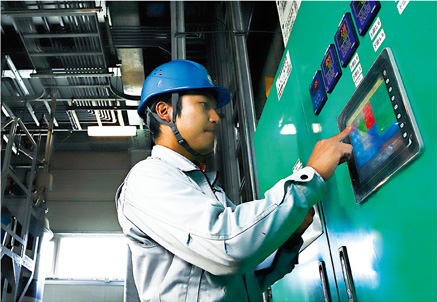

We thoroughly pursue quality-oriented, "very helpful" services, and are currently undertaking periodic inspections for approximately 100 companies.
We maintain the capacity and extend the service life of existing water treatment systems through rigorous inspections and propose improvements and renewal projects to meet new requirements for existing facilities that change while they are not in operation. One of the most popular areas of improvement and renewal projects in maintenance support is proposals for "reduction of labor and unmanned operation," which is considered an urgent issue in the manufacturing industry.
Typical examples include updating systems that display the remaining amount of chemicals used daily on the control panel and introducing non-contact sensors to reduce the need for daily sensor cleaning.
In addition, we create management roadmaps for the entire facility to minimize wear and tear on instruments and components and reduce capacity.
We also offer a management plan that averages the management budget throughout the year and achieves a longer service life for the facility.
◇ Example of Improvement for Compliance with Discharge Standards
We were contacted by the customer who said, "Recently, the concentration of impurities in the wastewater has been increasing." We conducted an on-site survey of the current wastewater volume and concentration. We proposed to update the equipment, change the chemicals used, and modify the injection volume in consideration of various conditions, such as whether the cause was related to the capacity of the facility or the suitability of the treatment chemicals, and restored the facility to a state in which it could be operated safely.
◇ Example of improvement from an "in-house" regenerative ion exchange tower to a "commissioned" regenerative ion exchange tower
We proposed using an "in-house" regenerative ion exchange tower to reduce the customer's workload for regeneration work and treatment of regenerated effluent, as well as the burden on wastewater treatment water quality. As a result, we could reduce the workload and environmental risk by upgrading to the "consignment" type regenerative ion exchange tower from a comprehensive standpoint.
◇ Example of updating wastewater treatment equipment to accommodate line expansion
We were notified that the wastewater volume would be doubled due to the addition of a new line. Therefore, we verified whether the current role of the system could handle the situation. Then, we discussed and proposed the optimal treatment method together with the customer to determine whether it would be possible to respond by changing or improving some of the equipment or whether a more substantial update would be necessary.



